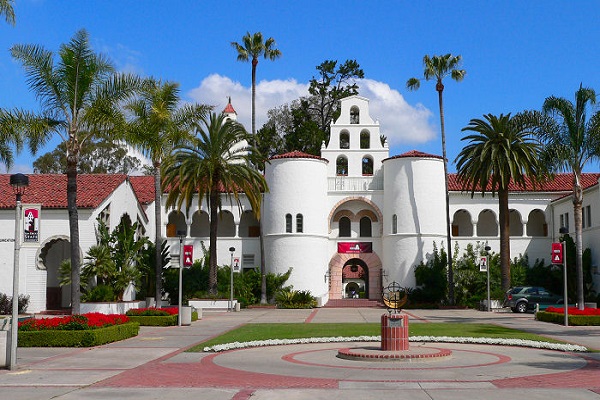San Diego State University President Joins California Governor Newsom for Lithium Valley Progress Update
San Diego State University President Adela de la Torre joined California Gov. Gavin Newsom and Imperial County officials Monday to give an update on progress toward the state and country’s ambitious goals for Lithium Valley.
The group spoke at Controlled Thermal Resources (CTR) U.S. headquarters at a lithium-extraction plant in Calipatria near the Salton Sea, 130 miles east of San Diego. The region was coined “Lithium Valley” following the discovery of one of the world’s largest underground reserves of the light metal, an element key for the creation of batteries and other renewable-energy technologies. Estimates place the amount of lithium available for sustainable extraction at up to 15 million metric tons, enough to supply one-third of global demand. The lithium has a potential value of $500 billion to $1 trillion.
Government, industry and community leaders at the event all spoke to a strong partnership at the local, state and federal levels, not only economically, but also with respect to the environment and the ideals of equity and inclusion for local residents.
“There’s a sense of urgency to meet this moment and meet the needs of this community. It’s about people and the lived experience,” said Newsom. “When we talk about equity, we’re not just talking about righting past wrongs, we’re talking about creating new opportunities and partnerships. There has never been a commitment of this scale and opportunity in this state.”
SDSU and state officials are aligned in believing science, technology, engineering and math (STEM) education is a vital pathway to unlocking career and economic development opportunities for the region.
“We’re going to be able to have homegrown highly skilled individuals not only with bachelor’s degrees but, with the new legislation moving forward, with doctoral degrees in manufacturing engineering and chemistry,” said de la Torre. “This is important because we need to produce jobs for people who are here and we have to create wealth that stays here.”
Following an investment by SDSU for new faculty, student centers, counselors, research programs, and academic and student-life infrastructure at SDSU Imperial Valley, Newsom championed an additional $80 million investment from the state in its 2022-23 budget to create a new STEM building on the SDSU Imperial Valley Brawley campus. It will include state-of-the-art classrooms, labs, offices, core facilities and collaborative spaces for public and private partners to work side by side with faculty and students. It will also give SDSU Imperial Valley the capacity to double enrollment, from 1,000 to 2,000 students.
“Our plans for more educational opportunities, more degree access, and more economic development align perfectly with the local, state and federal excitement over Lithium Valley,” said de la Torre. “Our graduates will go on to become the highly skilled workforce that Lithium Valley needs to thrive. And this historic initiative will drive not just the Valley’s economy, but the energy needs of our nation.”
The SDSU STEM building is expected to open in the fall of 2025. With campuses in Brawley and Calexico, SDSU is the only four-year public university in the region and is making affordable four-year STEM degrees available in Imperial Valley for the first time. Along with chemists and engineers needed for lithium extraction, SDSU will train graduates for other high-quality careers that will come with the region’s economic development and growing population, including health care workers, teachers, business leaders and public-service experts.
de la Torre emphasized the importance of the public-private partnership in the expansion of the SDSU Brawley campus, which will create opportunities not only for classroom education but also for student internships and high-paying careers. She earned cheers from attendees when she drew parallels between the progress in Lithium Valley and the success of the campus’s beloved basketball team.
“Friday, we will be playing Alabama and I want you to know that many pundits said we would not reach that point,” she said about the Aztecs reaching its third NCAA Sweet 16 in school history. “Five years ago, people said we’re not going to reach this point in Imperial Valley, and look at us today…this a great day for Lithium Valley and it’s a great day for San Diego State.”
Imperial Valley is a historically underserved region with a poverty rate of approximately 40 percent higher and an unemployment rate four times higher than the State of California overall.
According to CTR CEO Rod Colwell, his company’s plant is already extracting enough lithium, in a clean closed-loop system, to supply 5 million electric-vehicle (EV) batteries per year. Five million EVs on the road, he said, replaces the use of 1.95 billion gallons of gasoline per year and eliminates the creation of 23 million metric tons of carbon dioxide from exhaust emissions. CTR has long-term agreements in place to supply EV products and technologies to major automakers and foresees the creation of up to 12,000 local green jobs.
California Assemblymember Eduardo Garcia (D-Coachella) praised Newsom in his remarks. “You said Imperial County would be a large part of your climate and environmental goals and they are, so thank you for living up to that commitment,” he said. “The state has already committed $1.5 billion to the region and we’re talking about doing more to reinforce the vision that’s been laid. This is only the beginning.”
U.S. Congressman Raul Ruiz (D-Indio) echoed de la Torre’s commitment to ensuring that, with an eye toward sustainability, Lithium Valley creates opportunity and prosperity for the residents of Imperial Valley.
“All of this is about people and about the human faces here who have been left out and left behind,” he said. “It’s the people who live here who rely on these jobs and who breathe this air. Lithium Valley will protect our community’s health while advancing their opportunity to advance and grow.”

